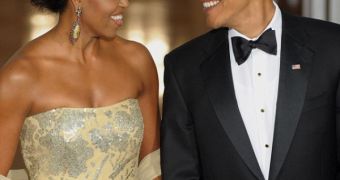How we perceive color, they say, is entirely a subjective matter, for one person’s turquoise can be another’s sea-green, and the list could go on like this for ever. In fashionspeak, “nude” refers to a pale pastel hue that is between pale peach and champagne. Because of the dress that First Lady Michelle Obama wore at a state dinner, the neutrality and potential racial offensiveness of this hue has been brought to attention again, the Telegraph says.
Again, how we label colors is a matter of perspective, which is even more obvious in the case of fashion designers, who might name a particular shade they use anything from “moonbeam” to “crazy monkey,” and we’d only know what it refers to if we saw it with our eyes. It’s not that Mrs. Obama chose to wear a dress the color of champagne that got people up in arms, the British publication says, but rather the way the creation was described: first by Naeem Khan, who designed it, and then by the Associated Press.
“Mrs. Obama wore the gown in question, a one-off by the American designer, Naeem Khan, to a state dinner at the White House, for the Indian President, Manmohan Singh, and his wife, Gursharan Kaur; a gracious and courteous gesture which paid tribute to Khan having been born in Mumbai,” the Telegraph writes of the gorgeous design donned by the First Lady on this special occasion. Indeed, it wasn’t until the gown had to be described that people started noting the lack of neutrality and inappropriateness of the term mentioned above.
“Khan himself called the gown ‘a sterling-silver sequin, abstract floral, nude strapless gown.’ The Associated Press reported it as ‘flesh,’ a description which caused an immediate retort from one newspaper editor: ‘whose flesh?’ AP immediately revised the description to ‘champagne.’ What Khan, himself an Indian, intended as a ‘fashion description’ has opened a can of worms, revealing the careless manner in which ‘fashionspeak’ can, albeit unwittingly, cause offence,” the Telegraph explains.
So, while terms like “flesh colored” might seem harmless at a first glance, on second thought, they’re actually potentially very offensive for they do not take into account the fact that skin is not all pale rosy. Veronique Henderson, creative director of the image consultancy Color Me Beautiful, tells the Telegraph this is fashion’s way of standardizing race, in more or less words – and judging by the kind of media this story is generating, she’s not the only one to see matters this way.

 14 DAY TRIAL //
14 DAY TRIAL //